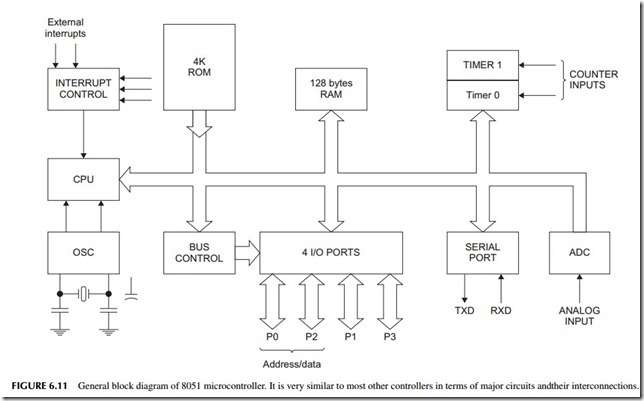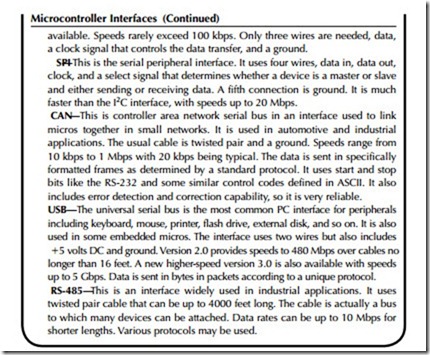POPULAR MICROS
The first practical microprocessors and microcomputers became available in the mid-1970s. Over the years lots of different models have been developed. As semiconductor processing technology has improved over the years, it has become easier and cheaper to put more circuits on a chip plus the memory that earlier was always external. And processing speeds have multiplied many times over. Today’s embedded controllers are indeed complete computers on a chip and they run at very high clock rates. And their cost is low. In high-volume manufacturing, an embedded controller can cost less than $1.
Most of the initial processors were 8-bit devices. These are still popular today. Larger, faster processors are available for not much additional cost. Sixteen- and 32-bit processors are commonplace. Even 64-bit devices are available if needed. Many are individual chips, while others are available only as cores on a larger systems chip. Following is a summary of a few of the most widely used processors.
The 8051 is one of the oldest but still widely used. It was originally developed by Intel in the late 1970s and 1980s. It is still around and available from a half dozen or more companies. The more recent versions are faster and have more memory and I/O features than the original. Original clock speeds were only 8 to 12 MHz, but today you can get models with a clock rate up to 100 MHz.
A general block diagram of the 8051 is given in Figure 6.11. The 8051 features an internal RAM of 128 or 256 bytes but can handle 64 or 128 KB of RAM externally. The internal ROM can be had from 512 bytes to 128 KB. Some models also feature flash memory. As for I/O ports, the figure shows four 8-bit parallel I/O ports. You can get a standard serial port called a UART, and more specialized I/O ports such as SPI and I2C. See the Interfaces sidebar in this chapter. Many models also come with an internal 10- or 12-bit ADC.
A few other items in this diagram that were not previously discussed are the clock, interrupts, and timers. The clock is an oscillator that controls all operations in the micro. Its frequency is usually set by an external crystal that maintains a precise and stable frequency. The higher the frequency, the faster the operations. Fast is good.
An interrupt is, as its name implies, an external signal that can interrupt the CPU when an important event occurs. It can signal the CPU of the event and even cause the CPU to stop executing the current program and jump off to another program to deal with the interrupt.
Timers are usually just one or more up/down counters than can be pro- grammed with various count values. These are used to implement count functions in programs and to provide timing operations for I/O operations. Most controllers have one or more timers.
68HC11
Another widely used 8-bit controller is the Freescale 68HC11 and its various versions. There are dozens of offshoots and variations. It has two 8-bit accu- mulators and one 16-bit accumulator. Total memory space is 64 KB with 128, 256, or 512 bytes of RAM, and up to 48 KB of ROM program memory. Different versions have all the interfaces, both parallel and serial, and some models have a built-in 8-bit ADC. A 16-bit version called the 68HC12 is also part of the product mix.
PIC Processors
Microchip Technology makes one of the most widely used 8-bit controllers. Called PIC processors, they are extremely simple and cheap. There are hun- dreds of versions with different memory sizes and configurations and various mixes of interfaces. One of the simpler versions is the 16C54. It has a single
working register, W, that is the accumulator. It uses a bank of 24 to 73 registers for RAM. ROM for program storage ranges from 512 bytes to 2 KB. I/O occurs via 4- or 8-bit parallel ports. Larger versions have more RAM and more ROM, higher clock speeds, a built-in ADC, and special network interfaces like CAN. Several 16-bit versions are also available.
MPS430
A typical 16-bit microcontroller is the Texas Instruments MSP430. It has 16 GPRs and a clock speed of 16 MHz. On-chip RAM is SRAM, and can be had in versions with 128 bytes to 10 KB. ROM for the program is flash from 1 KB to 120 KB. It has an ADC on board, a DAC, timers, and all the common serial interfaces. It is a popular chip because its low power consumption makes it ideal for portable and battery-powered devices.
32- and 64-Bit Processors
As it turns out, it is almost as cheap and easy to make a 32-bit processor as it is to make an 8-bit device. For that reason, for a few cents more, designers can make their products faster and more powerful by selecting a 32-bit device. With this many bits being processed at the same time, it is possible to move more data faster, compute with increased resolution, and to perform much more complex operations faster and easier. Thirty-two-bit processors can also address much more memory. A few years ago, 32-bit processors were reserved for only the largest or most critical of needs. Today, the 32-bit processor is almost as widely used as the 8-bit processor.
Three devices account for most applications. They are made by ARM Holdings, Freescale, and MIPS. ARM is the name of a British company that invented a super-simple, fast, and flexible 32-bit processor that does every- thing well at very low cost. It is referred to as a reduced instruction set computer (RISC) processor. It has a few simple instructions but is extremely fast. ARM does not actually make chips, but instead licenses the design to others. There are several vendors of ARM processors but most of them are actually cores that are integrated on-chip with other circuits to form a system on a chip (SoC). With over 75% of the market share, you are sure to encounter an ARM device sooner or later. Chances are you own at least one inside a product such as a cell phone, which is where most are used.
Freescale ’s PowerPC is another popular 32-bit processor. It was originally used in Apple Macintosh computers but no more. IBM used it widely and still does in some products. Many embedded versions have since been made. Its primary usage is in communications, networking, automotive, and industrial applications.
For really super processing power, the MIPS processors are a popular choice for certain embedded applications. These devices come in 32-bit as well as 64-bit models, in case you really have a hot application for which nothing else will do. The MIPS processors are great at advanced math and have excellent resolution.
Microcontroller Interfaces
An interface is the circuitry that connects an embedded controller to the outside world. Initially, all I/O in early micros was just the parallel data and address buses extended to accommodate additional I/O circuitry. Today, much of the I/O inter- face circuits are put right on the same chip with the rest of the micro. Following are the most widely used interfaces you are likely to encounter. All of these are serial interfaces. Parallel I/O is still used, but today the preference is serial I/O because of fewer interconnecting lines.
RS-232/UART—This universal asynchronous receiver-transmitter is actually the physical circuitry implementing a popular serial interface standard referred to as RS-232. It was originally developed for connecting computers to teletype machines and early video terminals. It is still used today, especially for connecting to industrial equipment for monitoring or control.
The RS-232 interface sends and receives data in bytes (8 bits) plus two extra bits, called Start and Stop bits, that tell the receiving device when the data begins and ends (see Figure 6.12 ). The logic levels are- 3 to- 25 volts for a binary 1 and +3 to + 25 volts for a binary 0. Typical voltage levels are in the 5- to 12-volt range. The data rate is slow, typically from 300 bps to 115.2 kbps. Standard data rates are used, so no clock signal is needed. Common speeds are 2400, 9600, and 19,200 bps. The physical communications medium is a two-wire (signal plus ground) cable that can be up to 50 feet long. Special 9- and 24-pin connectors are part of the standard. Many PCs and laptops still have a 9-pin RS-232 port. I2C—Shorthand for inter-integrated circuit or I squared C, this is a low-speed serial bus that is used for sending data from one chip to another on the same PC board or over short cables between two pieces of equipment. The data rate is typically in the 10 kbps to 400 kbps range, but a faster version (3.4 Mbps) is


